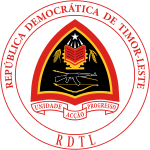| Indonesian invasion of East Timor Operation Lotus | |||||||||
|---|---|---|---|---|---|---|---|---|---|
| Part of the Cold War in Asia | |||||||||
East Timor map during the Indonesian invasion Indonesian soldiers pose in Batugade, East Timor with a captured Portuguese flag, November 1975 | |||||||||
| |||||||||
| Belligerents | |||||||||
|
| |||||||||
| Commanders and leaders | |||||||||
| Strength | |||||||||
| 35,000 | 20,000[3] | ||||||||
| Casualties and losses | |||||||||
| 1,000 killed, wounded or captured[4][5] |
185,000+ killed, wounded or captured (1974–1999)[6] (including civilians) | ||||||||
| History of East Timor |
|---|
 |
| Chronology |
| Topics |
|
|
The Indonesian invasion of East Timor, known in Indonesia as Operation Lotus (Indonesian: Operasi Seroja), began on 7 December 1975 when the Indonesian military (ABRI/TNI) invaded East Timor under the pretext of anti-colonialism and anti-communism to overthrow the Fretilin regime that had emerged in 1974.[7] The overthrow of the popular and short-lived Fretilin-led government sparked a violent quarter-century occupation in which approximately 100,000–180,000 soldiers and civilians are estimated to have been killed or starved to death.[6] The Commission for Reception, Truth and Reconciliation in East Timor documented a minimum estimate of 102,000 conflict-related deaths in East Timor throughout the entire period from 1974 to 1999, including 18,600 violent killings and 84,200 deaths from disease and starvation; Indonesian forces and their auxiliaries combined were responsible for 70% of the killings.[8][9]
During the first months of the occupation, the Indonesian military faced heavy insurgency resistance in the mountainous interior of the island, but from 1977 to 1978, the military procured new advanced weaponry from the United States, and other countries, to destroy Fretilin's framework.[10] The last two decades of the century saw continuous clashes between Indonesian and East Timorese groups over the status of East Timor,[11] until 1999, when a majority of East Timorese voted overwhelmingly for independence (the alternative option being "special autonomy" while remaining part of Indonesia). After a further two and a half years of transition under the auspices of three different United Nations missions, East Timor achieved independence on 20 May 2002.[12]
- ^ Indonesia (1977), p. 31.
- ^ Ginting, Selamat (17 April 2021). "Pukulan Jenderal Komando ke Perut Wartawan". Republika. Retrieved 14 March 2021.
The control of the East Timor operation is in his [Widjojo Soejono] hands. ["Kendali operasi Timor Timur ada dalam genggamannya."]
- ^ "INDONESIA INVADES". HISTORY OF EAST TIMOR. SOLIDAMOR. 2005. Archived from the original on 18 March 2005. Retrieved 30 May 2006.
- ^ Power Kills R.J. Rummel
- ^ Eckhardt, William, in World Military and Social Expenditures 1987–88 (12th ed., 1987) by Ruth Leger Sivard.
- ^ a b „Chega!“-Report of Commission for Reception, Truth and Reconciliation in East Timor (CAVR)
- ^ Dennis B. Klein (18 April 2018). Societies Emerging from Conflict: The Aftermath of Atrocity. Cambridge Scholars Publishing. pp. 156–. ISBN 978-1-5275-1041-8.
- ^ "Conflict-Related Deaths in Timor-Leste 1974–1999: The Findings of the CAVR Report Chega!" (PDF). Final Report of the Commission for Reception, Truth and Reconciliation in East Timor (CAVR). Retrieved 20 March 2016.
- ^ "Unlawful Killings and Enforced Disappearances" (PDF). Final Report of the Commission for Reception, Truth and Reconciliation in East Timor (CAVR). p. 6. Retrieved 20 March 2016.
- ^ Taylor, p. 84
- ^ Fernandes, Clinton (2021). "Indonesia's war against East Timor: how it ended". Small Wars & Insurgencies. 32 (6): 867–886. doi:10.1080/09592318.2021.1911103. ISSN 0959-2318. S2CID 234831894.
- ^ "New country, East Timor, is born; UN, which aided transition, vows continued help" Archived 10 July 2011 at the Wayback Machine. UN News Centre. 19 May 2002. Retrieved on 17 February 2008.

